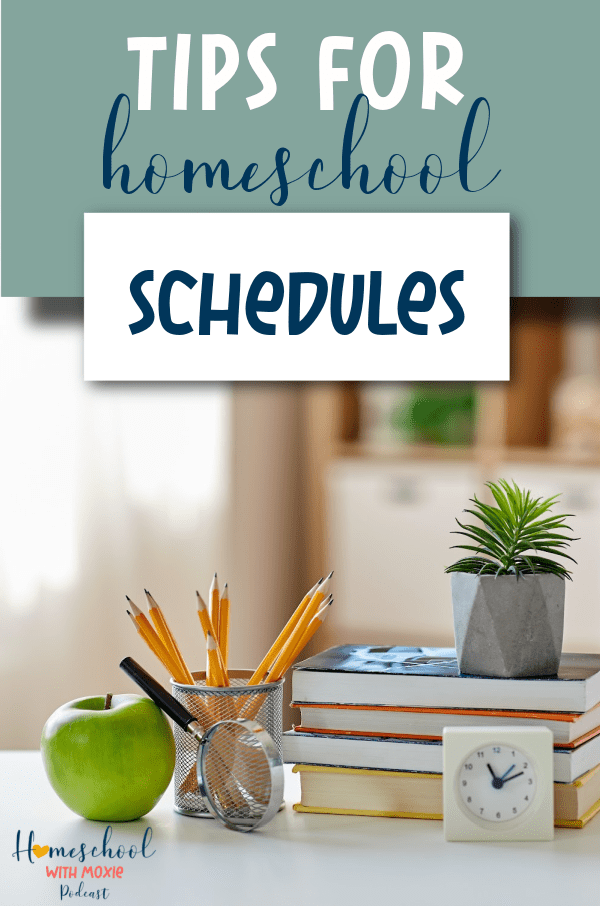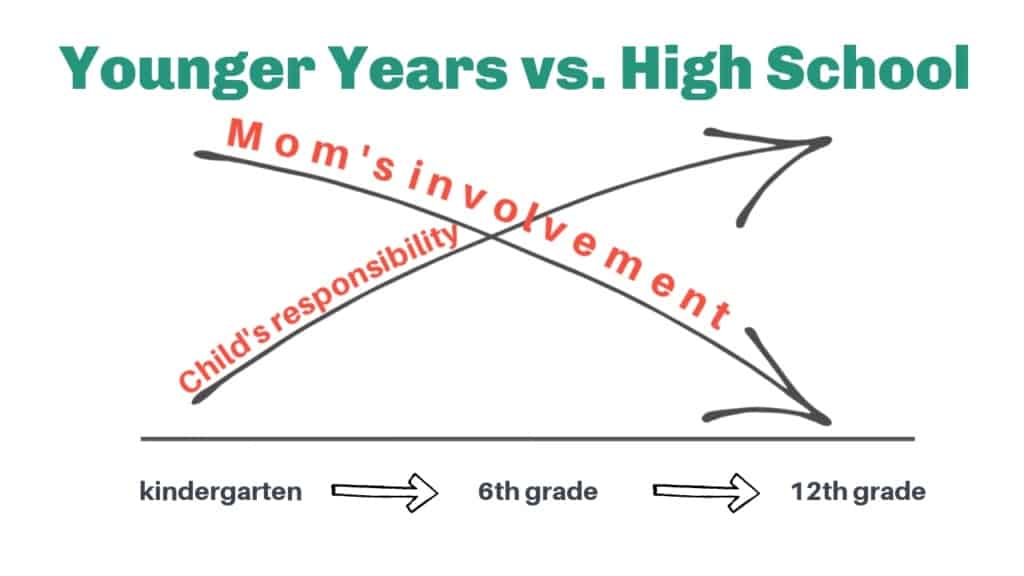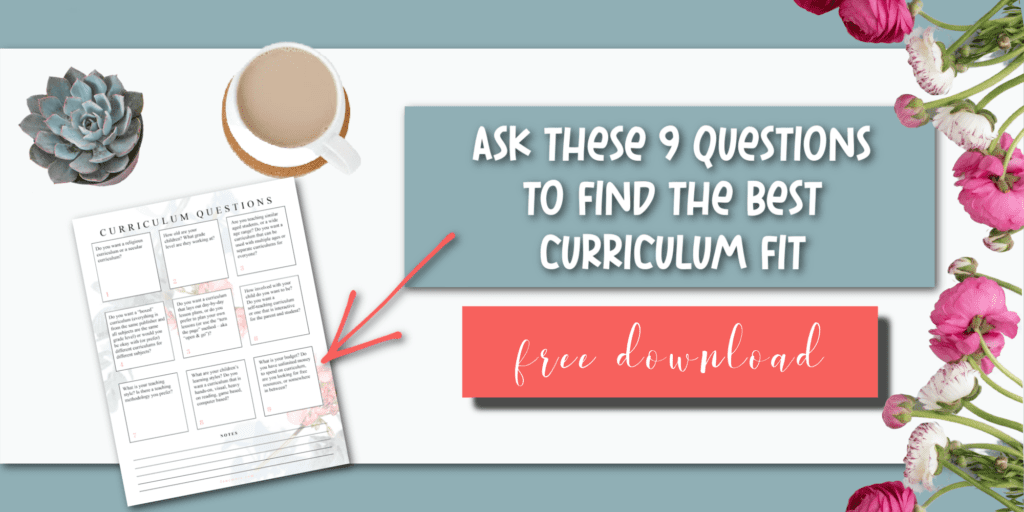As a former classroom teacher, now homeschooling my five kids for well over a decade, here are my best tips for creating a homeschool schedule that will give you both flexibility and productivity.
When families were suddenly homeschooling during the pandemic, there were strict “school at home” schedules flying all around Facebook and social media. While it might have worked temporarily, it’s not a great long-term solution. Here’s what you need to know about homeschool schedules.
In this post, we’ll cover these topics:
- Homeschool with Moxie podcast episode #76: Advice for homeschool schedules
- Homeschool with Moxie podcast episode #139: Daily Homeschool Schedule Tips
- How many hours a day should you homeschool?
- How do I create a daily schedule for homeschooling?
- Download sample homeschool schedules
Plus, there are several freebies throughout this post that will help you implement these strategies!
And I’ve joined forces with my homeschool blogging friends to bring you more Back to Homeschool Freebies & Ideas you can implement right now! Scroll down for the entire list.

My posts contain affiliate links.
Listen to the episode 76: Advice on Homeschool Schedules
In this episode, I bring you over a decade of homeschooling wisdom to help you create the most flexible, yet productive, homeschool routine.
You will learn:
- Why routines are better than schedules
- Go with your kids’ natural energy
- Remember that homeschooling doesn’t take as long
- You can craft a flexible 4-day school schedule
- Use lists, workboxes, or Trello
Throw away the thought that you need to recreate public school at home to be successful! Truth be told, trying to run a mini public school in your house will quickly lead to burnout – for the kids and for yourself!
Homeschooling is freedom. Embrace the flexibility that you have. Allow your kids to enjoy the learning process. You’re not a slave to a curriculum or to a schedule. Remember: you are raising life long learners, not checking off schedule boxes.
Listen to episode 139: Daily Homeschool Schedule Tips
In this episode, we talk through the main areas to consider when making a daily homeschool schedule. It’s the time of year when many of us are reevaluating what has worked in our homeschools and what hasn’t worked so far this year. Here are four tips to help you revamp your daily routine in order to help it fit YOUR reality on the ground.
Our sponsor for this episode is TalkBox.Mom – you can help your kids gain fluency in a foreign language! Grab their FREE language starter pack.
Use these coupon codes to save:
- Box & phrasebook – $20 off homeschoolwithmoxie20
- Start with Phrasebook only – $5 off homeschoolwithmoxie5
How many hours a day do you homeschool?
The Efficiency Factor
First, when asking how many hours a day you should homeschool, I think you need to consider the efficiency of a homeschooling model. Having a one-on-one tutoring approach as a homeschool mom and child is the very best way to educate.
Consider a traditional classroom where the teacher has to split their attention among 20 or 30 students. There is so much busy work, wasted time, administrative tasks, lining up, transitioning from one activity to the next, and so on. You likely remember how boring and slow paced much of school was for you.
Now compare that to being able to sit with your child and work through academics in only minutes or a few hours per day. By using assessment methods like narration, you are able to tell immediately whether your child understands the material or not. Then, you can fill in gaps in their understanding, or continue to challenge them with new concepts. You can vary the pace of the new material based on their ability. That means your children never have to be frustrated because they can’t keep up – the pace is flexible! And, your children never need to be bored because they have to wait for the rest of the class. Homeschooling is efficient, customizable, and the very best education model.
Grade Level Factors
First, you want to take into account the age of your child. Obviously, the younger they are, the less of an attention span they will have for any type of formal schoolwork. This is why approaching homeschooling as the natural passion-driven education that it is works wonders for kids of all ages, but especially in the early years.
For example, your kindergartener may only sit down for 10 or 20 minutes with you and review letters and their sounds and practice combining them into words. The rest of the day may look like they are “only” playing, but in that play, they are:
- working on fine motor skills
- creating stories and imaginary lands
- using math to count objects
- creating art
- making music
- learning vocabulary by talking with mom or listening to a read-aloud
- engaging with music appreciation through simply listening
- studying science by taking a walk outside and observing nature
- understanding geography by looking at a map and talking about where family members live
- plus so much more!
Do you see how, especially in the younger years, a strict and formal curriculum is not necessary to have a full and deep education?
Check out these related podcast episodes:
Now, your goal as a homeschool mom is to continually work yourself out of a job. That is, when your kids are younger, you will necessarily be more involved in the day-to-day homeschool instruction. However, by middle school, the responsibility and work load should be more evenly distributed between mom and the student. Finally, in high school, your student should be taking complete responsibility for his academics.

When your teens are earning credit for their homeschool high school transcript, they will need to complete 120-180 hours of work per course. That is, in a normal high school transcript, receiving one credit for Biology would mean that your student worked on biology every day for 180 days for about 45 minutes to one hour. So, depending on the number of credits they are working toward each semester, the number of hours required for their homeschool day will vary.
Homeschool Methodology and Curriculum
The next factor that will determine how many hours a day you homeschool will be your methodology and the specific curriculum you choose.
If you decide to be a traditional textbook homeschooler and require your sixth grader to work through five different textbooks per day for one hour each, then that’s a super long homeschool day!
But it doesn’t need to look like that. Obviously, in the high school years, your students’ schooling may look more traditional so they can fulfill requirements for graduation.
However, in grades K-8, you usually have the complete freedom to craft the kind of education you want. Definitely check your state or provincial laws first.
Comparing Methods
What do I mean by homeschool methodology?
Well, if you homeschool using the Classical Approach, then your children will have more emphasis on history, literature, and language studies. Of course, you’ll still do math and science, but the main part of your school day will be focused around those main topics and themes.
If you homeschool using a Charlotte Mason approach, then your day will look very hands-on with nature studies, art and music appreciation, and definitely lots of reading – real books, not twaddle! This method allows for a lot of flexibility and freedom to follow the beautiful and enjoyable parts of learning together as a family. It also allows you to seamlessly teach multiple ages together – which drastically cuts down on the number of hours you as the mom need to instruct your children each day.
Or, if you follow an eclectic approach, you will pick and choose the best approaches for each subject. So, you might teach science and history to all your kids in K-8 using hands-on unit studies. Math and language arts may be traditional textbook approach courses, with each child working independently. Finally, any extras may be done during morning time as a group. In this approach, can you see that completing a full day of your homeschool schedule may only take the morning hours, leaving all afternoon for hobbies and play?
Curriculum Options
The final consideration that will affect how many hours a day it takes to homeschool is the actual curriculum you choose to use. Obviously, curriculum that is user-friendly and doesn’t require a confusing and technical teacher’s manual will work best. We opt for open-and-go curriculum as often as possible. Look for curriculum written especially for a homeschool context.
Consider Looping
One scheduling tool that will help you streamline the number of hours needed to homeschool is called looping. Looping allows you to hit a bunch of subjects or topics in a rotation throughout the week. That way, if you somehow miss your looping time due to an appointment, you just pick up the next day where you left off.
The key to consistency with looping is to have a certain time of the day when you always do your loop subjects. Many homeschool families schedule in a morning time or use a morning basket. This is a great way to make sure you regularly hit the subjects in your loop.
Other families might have their loop right after lunch when everyone is together. This is what our family used to do when I would cover several subjects together for all my kids in grades K-8.
So, for example, here’s what your loop might look like. Choose a few subjects to include. These would not be your core subjects like math and language arts.

Here’s how your loop would work. If you decide to schedule in your loop right after lunch, then on the first day of school that week, you might start with music appreciation. The next day, you would hit science together. You might miss the following day of school due to an appointment after lunch. In that case, you just pick up your loop when you’re back to your regular schedule and cover history. Then, art is next. Finally, you would circle back to music the next day and continue on in this way.
Do you see how looping allows you to consistently cover subjects without the burden or time of scheduling them all in daily?
How Do I Create a Daily Schedule for Homeschooling?
I advocate for homeschool families to consider flexible routines instead of strict schedules. Sometimes we need to throw out the public school mindset when we’re homeschooling, because it just isn’t helpful.
Public schools and other traditional school settings have to have structure and strict schedules to be able to manage so many students. But when you’re homeschooling your own children, you can embrace the flexibility and freedom that comes along with it.
Here are additional posts and podcast episodes that deep dive into this concept of routines versus schedules:
- Why You Need Homeschool Routines Rather Than Schedules
- How to Get Ready for the Homeschool Year: Schedules & Routines
Routines
When you start to think about homeschooling routines that will work for your family, you have to ask – what is YOUR family like? Are they early risers? Late risers? Do you have babies or teens or both? Find a time to homeschool that allows you to work at your peak productivity. There’s nothing in the law that says your kids have to homeschool from 8-3 every day. Some families love to do everything before lunch. Other families like to sleep in and get started in the afternoon and into the evening because they have night owls. Do what works for you.
Routines simply help you answer the question: what should we do next?
In other words, when your kids wake up or start school, do they know the routine? Should they eat breakfast first, get a shower, do their chores? Can they start math independently? If they finish one subject, can they move on to the next? If you’re working with a sibling, what should they do if they get stuck?
So, when you create your routines, make sure to communicate them to the kids.
Most of the time, you will want to plan to cover the daily necessities first. That is, what subject is the hardest or most time-consuming? Do you want to get math out of the way first? Then plan that in your daily flow to happen first. You can create a priority list of subjects to plan your day.
In some past years, here’s what our daily routine looked like with multiple kids in K-8:
- Morning Time Loop
- Individual Subjects (math & language arts)
- Lunch
- Second Loop
Finally, make sure to plan around any extracurriculars that take you out of the house. You might reserve your afternoons for these courses and activities, along with trips to the library or other errands.
Work with Blocks of Time
As you can see from my sample daily routine above, there are no specific times mentioned. Math wasn’t schedule for 9AM and lunch wasn’t rigidly planned for noon.
Instead, our homeschool schedule was loosely based on blocks of time. Think of your blocks of time like this:
- early morning
- late morning
- early afternoon
- late afternoon
- evening (optional if you’re working on the side or you have late risers)
Planning Your Homeschool Schedule
So, how do you practically go about planning your homeschool schedule? I may be old school, but I like to plan it on paper first. Then, I move to digital tools to help my kids and myself stay on track throughout our homeschool week.
And always keep in mind that you are the master of your homeschool schedule. You can change things up if it’s not working for your family. Don’t ever be a slave to a curriculum or a schedule!
So, grab a piece of paper and list all the subjects down one side and all your kids’ name across the top. Fill in the course and curriculum plans for each kid for the next year, taking care to see if you can combine any kids.
For example, while math and language arts are best learned at the appropriate grade level, your kids in K-8 can learn the same history, science, and other electives together. This will greatly help you as the homeschool mom to be able to manage multiple ages without losing your sanity!
If you want a detailed look at my lesson planning strategy, then check out this short but practical workshop by clicking the graphic below.
Once you decide on specific courses and curriculum for each of your kids, then you need a system to keep everyone on task throughout the homeschool week.
The best tool we’ve found in the elementary years is to use a workbox. This visual and physical organizational system works especially well for kids with ADHD. Here’s a short video peek into how a workbox could be set up.
The best way to keep your teens on task and to help with accountability is to use a digital tool like Trello. We’ve used Trello for years now and my teens love it! Check out our detailed tutorials and videos showing how to get your homeschool schedule set up on Trello.
What NOT to do
- Don’t plan out a strict schedule like a traditional school (10:00-10:15 spelling, 10:15-10:30 writing). This will frustrate everyone if you get behind. And who’s to say science can’t take 2 hours if the kids are loving it?
- I don’t lesson plan (and you shouldn’t either). Instead, use open & go curriculum.
- Don’t start your first day in a lazy way with low expectations. You’ll never recover from it.
- Don’t do every subject for a long period of time on the first day or even the first week.
- Don’t expect the first week to go smoothly at all!
- Don’t let yourself sleep in the first few days of homeschooling. Get yourself ready first and be fresh for the kids.
Instead, do this
- Instead of using strict schedules, use routines or flow. (First, we’ll eat breakfast and do chores. Then, we’ll start together with morning time.)
- Start off the first day with your “ideal” flow. Teach the kids how each subject should be approached, where to find the supplies and resources, and how to work through their day.
- Take time to explain procedures. A procedure would be: where should I put my math paper when I’m finished? Do I correct the reading comprehension assignment on Tuesdays? When I read the history lesson, should I create a timeline in my history notebook?
- Take more time to work on procedures and routines the first week of school than actually getting to the academics. Don’t worry – the kids won’t fall behind. Public schools do this too.
- Set reasonably high expectations the first few weeks of school. You can always ease up if needed later on, but you won’t be able to ramp back up once low expectations are set. I’m referring to expectations of effort, neatness, attitude, time spent, clean up, and so on.
- Communicate the flexible schedule and daily flow to your kids. For the younger crowd, workboxes and visual charts work great. For upper elementary to high school, we use Trello.
- Enjoy learning with your kids! Remember that children are naturally curious and enjoy learning new things.
What about Babies & Toddlers?
If you’ve ever tried to homeschool your older kids while corralling babies and toddlers, you know how challenging it can be. However, there are a few tips and strategies to keep in mind so that you don’t want to pull your hair out (on most days)!
Don’t wait for the perfect time to homeschool. Just do it with the younger kids around. A great way to make this work is to utilize morning time when you’re all informally on the couch or in the living room. That way, your toddlers are likely more happy because they’re with the family and you can still keep an eye on them while doing things like reviewing memory work, reading a book aloud, or talking about a history lesson.
Next, use nap time well. If you just find things too chaotic with the baby or toddler, then use their nap time for completing the hardest subjects. Naptime might become math time for your older kids. Just do what works in this season, knowing that it really won’t last forever.
Finally, give your littlest ones attention first thing in the morning. By meeting their emotional and physical needs first, you’ll be able to then move on to giving your attention to the school-aged kids.
Here’s a podcast episode about this topic: 6 Tips for Homeschooling Multiple Ages (including babies & toddlers)
Listen to episode 210: Prepping for Homeschool the Night Before
What are some of the things you should do everyday to prepare for the next homeschool day? This episode is full of actionable strategies!
Don’t forget to subscribe to the Homeschool with Moxie Podcast and listen on your favorite podcasting app.
Download Homeschool Schedule Planning Pages
To get you started creating your own flexible and productive homeschool schedule, download some blank schedule sheets below.
Your download will include a variety of 9 different planning sheets:
- Blank planning schedules for multiple kids
- Blank high school planning schedule
- Weekly Homeschool Time Block Planners
More Resources for New Homeschoolers
If you’re a new homeschool family, or beginning a new homeschool year, here are the steps to take:
Step #1: Declutter – When you have less stuff to touch, rearrange and put away each day, you are well on your way to a more successful homeschool experience. Don’t skip this step!
Step #2: Curriculum Organization – Your curriculum or plan is the backbone of your homeschool. Now, a word of caution – don’t let it control you. You are the master over your curriculum. If it’s not working, change it up. If you won’t finish the book this year, that’s not a problem!
But, without some kind of homeschooling philosophy or plan of studies, you will waft all over this year. I’m not advocating a straight-jacketed educational experience, but you do have to know what your big goals are. What is the governing WHY of your homeschool? Get clear on that, choose your curriculum or spine of studies, purchase the resources, then finally organize it in a way that works for how you do school.
Step #3: Homeschool Supplies – School supplies are super fun, but you could end up cluttering your house again or spending money you really don’t have. It’s okay to go super simple and to use what you have around the house!
Step #4: Schedules & Routines – Your homeschool schedule & routine will make or break your school year. Is this an overblown statement? I don’t think so.
When I was a classroom teacher, I knew that the routines I set in the first few days of school would carry through the entire school year. If I wasn’t consistent or didn’t have a clear pattern for how we did stuff each day, then there was too much opportunity for chaos to creep into my classroom. Even though you’re at home and schooling your own kids, your routines and still imperative. In fact, they might be even more important.
Back to Homeschool Freebies
If you haven’t already started planning for your new homeschool year, the time is quickly approaching! But don’t worry…we’ve got you covered!!

I have teamed up with some of my fellow homeschool bloggers to bring you some fantastic Back to Homeschool themed tips, resources, and even a few FREEBIES. Be sure to check them all out below!





Loved this episode. I have been exclusively homeschooling for 6 years now and the whole idea of getting rid of the word schedule and replacing it with the word routine has been something I have been saying all along. I even wrote my own blog post about it recently as well. Thanks so much for sharing your thoughts.